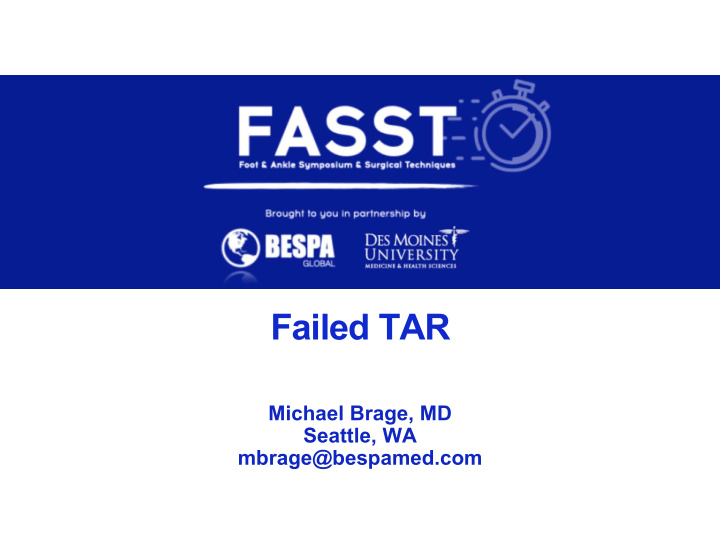



Failed TAR Michael Brage, MD Seattle, WA mbrage@bespamed.com
Disclosure • Consultant speaker: • Wright Medical, INC/Stryker • Bespa Global • Paragon 28 • Kinos • Integra
How long do primary TARs last? • A systematic review and meta ‐ analysis • Included 58 papers (7942 TARs) with an inter ‐ observer reliability (Kappa) for selection, performance, attrition, detection and reporting bias of between 0.83 and 0.98 • The overall survivorship was 89% at ten years with an annual failure rate of 1.2% (95% confidence interval 0.7 to 1.6) Zaidi R et al: J Bone Joint Surg, 2013, 95 ‐ B, 1500 ‐ 7 We don’t yet know the longevity of modern total ankles
Indications for revision Impingement Malposition of components Loosening of components Pain Infection Ligamentous instability
Problems encountered Component subsidence Bone defects Coexisting adjacent joint arthritis Hindfoot, midfoot deformities
Removal of custom talar stem
A simple algorithm
Revised algorithm… Surgeon’s Prosthesis Prosthesis choice salvageable unsalvageable
A case: prosthesis salvageable • STAR in since 2014 • Only recently painful • 10/10 pain
CT scans CT scans always show more
Revision Curettage cyst Outlining the depth
Salvaged: calcium phosphate cement, new poly A revision gastroc recession was performed
At 6 months
2 year follow-up
Motion at 2 years Only a few degrees of plantar flexion Dorsiflexion Plantar flexion
Prosthesis unsalvageable options: The options in the United States: •Wright Medical InBone 2 •Wright Medical Invision •Salto Talaris XT 2 Ankle Not options in my hands: •STAR •Salto Talaris Anatomic Ankle •Depuy Agility •Zimmer Trabecular Metal Ankle •Exactech Vantage •Paragon Ankle
Surgical Technique: Revision TAR General Assessment once prosthesis is removed assess talar insufficiency determine bone deficit assess the subtalar joint evaluate for fractures
Surgical Technique: Revision TAR Malleolar Fracture avoid malleolar fracture as much as possible fix malleolar fx with K-wires or screw
Surgical Technique: Revision TAR Place talar trial to assess residual talus Use lamina spreader Adjust talus cut freehand
Surgical Technique: Revision TA R Tibial Preparation leg placed and secured in “the” foot holder proper alignment obtained with AP and Lateral alignment rods under C-arm tibia is drilled
Surgical Technique: Revision TAR Tibial Preparation • cutting block is lined up to the drill, then tibial cuts completed • tibia is reamed • tibial stems inserted until tibial tower construct is complete
Surgical Technique: Revision TAR Talus Preparation when there’s lots of talus • leg removed from foot holder • talar trial and trial PE liner inserted • trial components removed and talar stem is reamed • talar component is positioned • properly sized PE liner inserted
When there’s talar insufficiency
Fuse the subtalar joint
Use autograft from tibial cut
At one year
At 7 years
Motion at 7 years Dorsiflexion Plantar flexion
When there is even less talus..
Even less talus…
Level off residual talus until it lines up
At 6 months At 2 years
ROM at 6 months ROM at 2 years Dorsiflexion Dorsiflexion
ROM at 6 months ROM at 2 years Plantar flexion Plantar flexion
When there’s no viable talus 69 F hx of RA 6 years s/p R STAR TAA
CT shows very little viable talus left
Planning of the total talus replacement is based on a CAT scan of the opposite normal ankle. digital data then used to mirror it to fit the bad ankle
The prosthesis is then manufactured using a 3D printer to match the abnormal ankle
Talus made with InBone 2 dome
Final prosthesis
Intraoperative
2 years postop
Invision Revision System
INVISION Total Ankle Revision System The Next Step in Total Ankle Revision Arthroplasty Bone Loss & Tibial Coverage Standard and Long Tibial Tray Fixation & Stability lengths to allow optimum Modular Tibial stems cortical coverage for robust stability Multiple thicknesses to address Plasma spray and Tibial defects smooth options Talar Coverage Broad anatomic footprint to Poly Options provide cortical rim coverage Thickness options 2 sagittal sizing options to ranging from 6mm to 20mm maximize Talar neck coverage Joint Height Restoration Talar Plate with two Fixation & Stability thickness options to help Talar pegs positioned for restore natural joint height anterior bone purchase
Ballooning osteolysis
Invision System
Invision System
Failed STAR to Salto XT • 51 year old female • STAR implanted 2 years previous • Never helpful, always painful Courtesy Bruce Sangeorzan, MD
Failed STAR
Mechanical axis alignment
Sizing, cutting block placement
Talar trial placement
Final OR images
2 years….
Motion at 2 years….
50 F hx 2 years s/p Zimmer TAA from arthrodesis conversion
Intraoperatively
1year post-operatively
Thank you
Recommend
More recommend